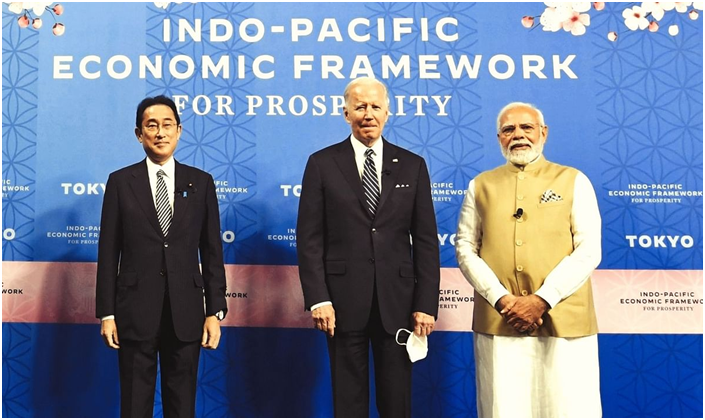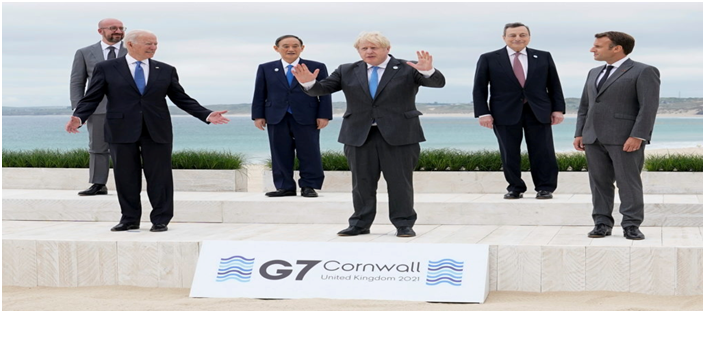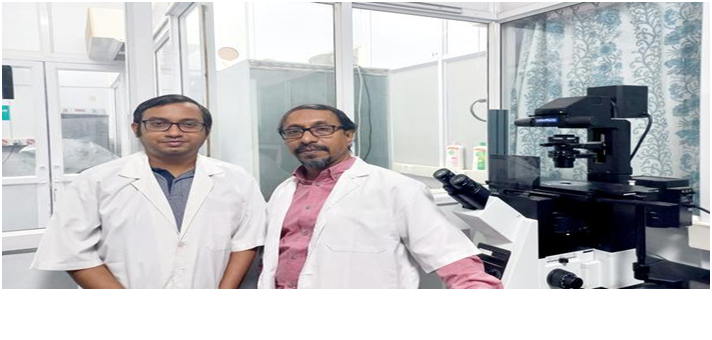India opts out of IPEFs trade pillar (GS Paper 3, Economy)

Why in news?
- India has as of now opted out of the trade pillar of the 14-member Indo-Pacific Economic Framework (IPEF).
- India would continue to engage with the trade track in the IPEF and will wait for the final contours to be decided on the trade pillar before it formally joins that pillar.
Key Highlights:
- All the other 13 Indo-Pacific Economic Framework for prosperity countries have joined the four pillars; trade, supply chains, clean economy and fair economy.
- On one pillar which deals primarily with trade, the contours of the framework particularly, any commitments required on environment, labour, the digital trade, public procurement are certain areas in which a broader consensus has yet to emerge amongst all the nations.
AboutIndo-Pacific Economic Framework (IPEF):
- The IPEF was launched jointly by the US and other partner countries of the Indo-Pacific region on May 23 in Tokyo.
- The 14 IPEF partners represent 40 per cent of global GDP and 28 per cent of global goods and services trade.
Members:
- US, Australia, Brunei Darussalam, Fiji, Indonesia, Japan, India, Korea, Malaysia, New Zealand, Philippines, Singapore, Thailand and Vietnam.
Four Pillars:
- The framework is structured around four pillars relating to trade, supply chains, clean economy, and fair economy (issues like tax and anti-corruption).
Trade:
- It intends to build high-standard, inclusive, free, and fair-trade commitments and develop new and creative approaches in trade and technology policy that advance a broad set of objectives that fuels economic activity and investment, promotes sustainable and inclusive economic growth, and benefits workers and consumers.
Supply Chains:
- IPEF is committed to improving transparency, diversity, security, and sustainability in supply chains to make them more resilient and well-integrated.
- To coordinate crisis response measures; expand cooperation to better prepare for and mitigate the effects of disruptions to better ensure business continuity; improve logistical efficiency and support; and ensure access to key raw and processed materials, semiconductors, critical minerals, and clean energy technology.
Clean Energy, Decarbonization, and Infrastructure:
- In line with the Paris Agreement goals and efforts to support the livelihood of peoples and workers, it plans to accelerate the development and deployment of clean energy technologies to decarbonize our economies and build resilience to climate impacts.
- This also involves deepening cooperation on technologies, on mobilizing finance, including concessional finance, and on seeking ways to improve competitiveness and enhance connectivity by supporting the development of sustainable and durable infrastructure and by providing technical assistance.
Tax and Anti-Corruption:
- It is committed to promoting fair competition by enacting and enforcing effective and robust tax, anti-money laundering, and anti-bribery regimes in line with existing multilateral obligations, standards, and agreements to curb tax evasion and corruption in the Indo-Pacific region.
G7 on Russian oil
(GS Paper 2, International Relation)
Why in news?
- Recently, Finance Ministers of all G7 countries, the U.S., Canada, the U.K., France, Germany, Italy, Japan, as well as the European Union announced their plan to “finalise and implement a comprehensive prohibition of services which enable maritime transportation of Russian-origin crude oil and petroleum products globally”, unless they are purchased at or below a “price cap” they will fix.
- The plan, however, doesn’t include Russian gas, which Europe is still quite dependent on.

What is the price cap plan?
- The price cap plan is the latest of the sanctions proposed by Western countries against Russia for its invasion of Ukraine, as well as Belarus for its support to Russia.
- For the past few weeks, U.S. and EU officials have been trying to convince countries including India, China and Turkey to join the coalition or to at least support the price cap, which they say is in the interests of all oil buyers from Russia as it will give them leverage to lower purchase prices.
How will it be enforced?
- For countries that join the coalition, it would mean simply not buying Russian oil unless the price is reduced to where the cap is determined. For countries that don’t join the coalition, or buy oil higher than the cap price, they would lose access to all services provided by the coalition countries including for example, insurance, currency payment, facilitation and vessel clearances for their shipments.
- In addition, the price cap is expected to be finalised when members of the G-20 countries meet in Bali in November, and will go into effect on December 5. This is the day that the European Union begins its sixth set of sanctions, to ban all Russia crude oil imports by sea, which would increase the pressure on Russia to reduce its selling price of oil.
- G7 countries say they are aiming to reduce the price of oil, but not the quantity of oil that Russia sells, so as to control inflation globally while hurting the Russian economy and its ability to fund the war in Ukraine. This could only work, of course, if all countries joined the coalition.
- However, if Russia is able to sell its price higher than the price cap, it would mean a huge squeeze on oil available to the coalition countries, especially the G7 which are major consumers, and could result in oil prices sky-rocketing.
How has Russia reacted to the plan?
- Russian President Vladimir Putin has lashed out at the plan, warning that Russia would not supply “anything at all” if it contradicts Russian interests.
- In September, Russia also announced a halt on all supplies via the Nord Stream 1 pipeline to Europe due to “maintenance issues” arising from the EU sanctions already in place, raising fears of a very difficult winter for European countries.
Will India comply with the price cap?
- The price cap is only the latest in a number of sanctions to hurt the Russian economy that the U.S. and EU have tried to bring India on board with.
- They have been asking India to change its uncritical stance on Russia at the United Nations, to cutting down oil imports, to stopping defence and other purchases from Russia, and to avoid the rupee-rouble payment mechanism that circumvent their sanctions.
- Thus far, India has not obliged, and there is little indication that India is likely to, just yet. India’s oil intake from Russia, which was minuscule prior to the war has soared 50 times over.
- At the Eastern Economic Forum (EEF) in Vladivostok, Indian Prime Minister said he wanted to “strengthen” ties with Russia in the energy field and boost India’s $16 billion investment in Russian oilfields.
Way Forward:
- Now, Indian Prime Minister will attend the Shanghai Cooperation Organisation summit in Uzbekistan, where the price cap issue will no doubt be discussed from the opposite viewpoint to the G7’s.
- It also remains to be seen whether India will bargain with the U.S. to set aside sanctions against Iran and Venezuela, from which it cancelled oil imports under pressure from the U.S. in 2017-18, in exchange for joining the price cap coalition.
Rabies Risk &Vaccine
(GS Paper 3, Science and Tech)
Why in news?
- The recent death of a 12-year-old girl in Kerala from rabies, despite having multiple inoculations of the vaccine, has raised questions on the efficacy of rabies vaccines in India and their availability.
How does a rabies vaccine work?
- Rabies is a disease that is caused by a family of viruses called the lyssaviruses and found in a range of mammals.
- The virus targets the central nervous system and is nearly 100% fatal to the host animal if it succeeds in infecting it.
- Though many animals from cats to crocodiles can be transmitters of the virus, it is most likely to spread to people from the bite of an infected dog or a cat as they are the most common pets.
- Despite being potentially lethal, the virus is slow-moving and it can be several weeks before the disease manifests into a fatal encephalitis which is why administering a vaccine, even after being bitten by a rabid animal, is effective.

Vaccine strategy:
- A shot of rabies immunoglobulin (rabies-antibodies against the virus derived either from people or horses) followed by a four-week course of anti-rabies vaccine, is nearly guaranteed to prevent rabies.
- This translates to the first dose being given on the same day as the immunoglobulin followed by vaccinations on the 3rd, 7th and 14th day.
- There are other regimens, such as five shots which include one on the 28th day approved by the World Health Organization (WHO) which clinics may consider, depending on the availability of the vaccine.
How is the vaccine made?
- The vaccine is made up of an inactivated virus that is expected to induce the body into producing antibodies that can neutralise the live virus in case of infection.
- There are also test vaccines that involve genetically modified viruses. There is no single-shot rabies vaccine or one that offers permanent immunity.
- There are mainly two ways of administering the rabies vaccine. One, called post-exposure prophylaxis (PEP),is given to persons who have been exposed via a bite to an animal suspected to be infected. The vaccines are administered either into the muscles, or into the skin.
- It can also be given ahead of time to persons who have a high risk of being infected, such as veterinarians, animal handlers, areas with a high number of rabies infection, by what is called Pre Exposure Prophylaxis (PrEP).
- The advantage of a PrEP is that if bitten, one doesn’t need a immunoglobulin injection, and two subsequent shots of the vaccine will suffice for full protection, unlike the four-course prescription in the case of PEP. However, the WHO doesn’t recommend PrEP as a general preventive.
Are rabies vaccines easily available in India?
- According to the Health Ministry, there are at least six rabies vaccines approved for India. They all contain inactivated virus made of duck, chicken or human cell cultures and are marked as safe, efficacious and with long immunity.
- Rabies vaccines are available for free in government dispensaries though vaccines administered in a private clinic can cost up to ₹500 per dose. However, reports of hospitals running out of vaccines continue to surface and knowledge about vaccines and treatment is still inadequate in India.
- The Health Ministry has said that no centralised database of vaccine availability is maintained, being a State-procured product, but that shortage had been reported in Punjab, Haryana, West Bengal and Karnataka.
- The WHO says India is endemic for rabies and accounts for 36% of the world’s deaths.
- About 30-60% of reported rabies cases and deaths in India occur in children under the age of 15 years, as bites that occur in children often go unrecognised and unreported.
What about vaccines for animals?
- Given that rabies treatment requires multiple shots of vaccine as well as immunoglobin, sticking to the schedule is challenging. Governments of countries where rabies is endemic have frequently set targets to eliminate the disease,India has committed to do so by 2030.
- Yet it is widely acknowledged that this elimination requires vaccination of dogs. Like in people, vaccinating animals too doesn’t guarantee lifelong immunity from the disease.
- Because dogs are deemed responsible for 99% of all rabies infections in people, the government in its 2021 plan, called the ‘National Action for Plan — Rabies Elimination’, aims to vaccinate at least 70% of all dogs in a defined geographical area annually for three consecutive years.
- With this, a degree of herd immunity is expected leading to eventual elimination within eight years. Rather than inoculate all dogs, which is not feasible, the plan is to identify ‘rabies hotspots’ across the country and target them.
JNCASR’s novel molecule prevents obesity in mice
(GS Paper 3, Science and Tech)
Why in news?
- Recently, researchers at Jawaharlal Nehru Centre for Advanced Scientific Research (JNCASR), Bengaluru have discovered that one rarely studied chemical modification of histone; lysine butyrylation, critical for fat cell development that underlies obesity manifestation.
- This finding encouraged them to search for a small molecule that could specifically inhibit this modification and thereby arrest or ameliorate obesity.
Why obesity is a focus of research?
- The developed world suffers from numerous cases of obesity due to a more sedentary mode of life offered by the comforts of the first world. In contrast, in the developing world, due to irregular food habits and economic stress, a large number of individuals have an accumulation of visceral fat especially in the stomach area as well as in the liver.
- Although obesity is more of a lifestyle-related health disorder, it can lead to several other diseases such as non-alcoholic fatty liver disease, diabetes and osteoarthritis. Surprisingly, there are no reliable drugs available for obesity and its associated disorders.
- While there are several drugs undergoing clinical trials for tackling obesity, many have already fallen through due to undesirable side effects in human patients.
Epigenetics:
- Over the past two decades, JNCASR has been working on how the modifications of the gene rather than the gene sequence itself can regulate gene function. This branch of molecular biology is called epigenetics.
- The epigenetic changes are reversible and directly correlated with habits as well as social and environmental cues.
- Human genetic material DNA is wrapped around protein balls called histones to form the highly organised genome. Different chemical modifications of both DNA and histones can dictate the fate of genes in terms of them being switched on or remaining switched off. This on/off balance of gene expression is critical for health and disease.

Key Findings:
- After many years of effort, they could finally demonstrate that a semi-synthetic derivative of garcinol, a molecule naturally found in Garcinia indica (kokum) fruit rind, could selectively reduce the levels of this modification by inhibiting the catalytic activity of the enzyme responsible for it, the master epigenetic enzyme p300.
- Since this molecule (LTK-14A) is very specific for only one enzymatic activity of the multi-functional enzyme p300, they expected minimal toxicity from this compound for biological applications.
Protective effect:
- As per traditional knowledge, kokum ( Garciniaindica) extracts have been known to have a protective effect against obesity. However, its exact molecular targets were not known. Furthermore, its major chemical constituent garcinolwas found to be toxic as it targets many enzymes non-specifically.
- The semi-synthetic molecule, LTK-14A, could offer greater efficacy due to targeted inhibition of the less abundant butyrylation modification that becomes relevant in the context of fat cell development.
Outcome:
- They have found that this molecule not only inhibits fat synthesis in mice cell line but also prevents obesity in mice feeding on high fat-diet. Very significantly, this molecule could reduce the weight of genetically obese and highly diabetic mice as well.
- Furthermore, administration of this inhibitor could reduce fat accumulation in the liver also, making it a suitable candidate for being used against non-alcoholic fatty liver disease.
Way Forward:
- They have also performed a few pre-clinical tests which indicate that this molecule is almost non-toxic. To increase its efficacy, they have also made a formulation with this molecule as its active component.
- This discovery is all set for the next stages of drug development.





